Vodafone: Understanding Customer Behaviour Through Marketing Theories
VerifiedAdded on 2023/05/28
|7
|1674
|71
Essay
AI Summary
This essay provides an analysis of customer behavior and its implications for Vodafone's marketing strategies. It discusses key principles of customer behavior, such as offering social currency, including triggers, striving for emotional connections, and providing practical value. The essay also explores various customer behavior theories, including the reasoned action theory, Maslow's motivation need theory, Hawkins' theory of impulse buying, and the Engel-Kollat-Blackwell theory. It emphasizes the importance of customer satisfaction and understanding customer needs to develop effective marketing campaigns for Vodafone. The research highlights the need for marketers to provide adequate information, create attractive product presentations, and motivate customers to prioritize their purchases based on their needs.
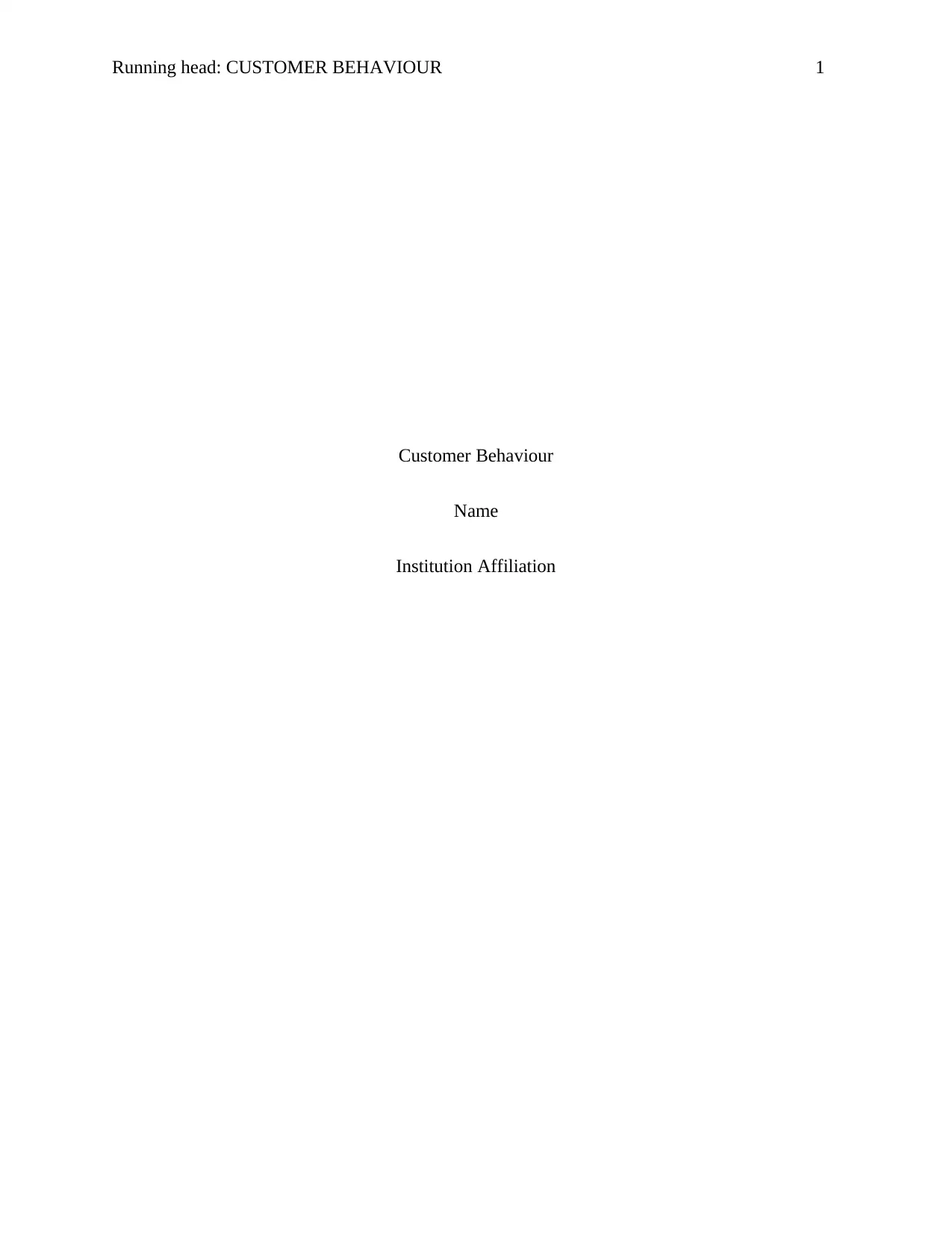
Running head: CUSTOMER BEHAVIOUR 1
Customer Behaviour
Name
Institution Affiliation
Customer Behaviour
Name
Institution Affiliation
Paraphrase This Document
Need a fresh take? Get an instant paraphrase of this document with our AI Paraphraser
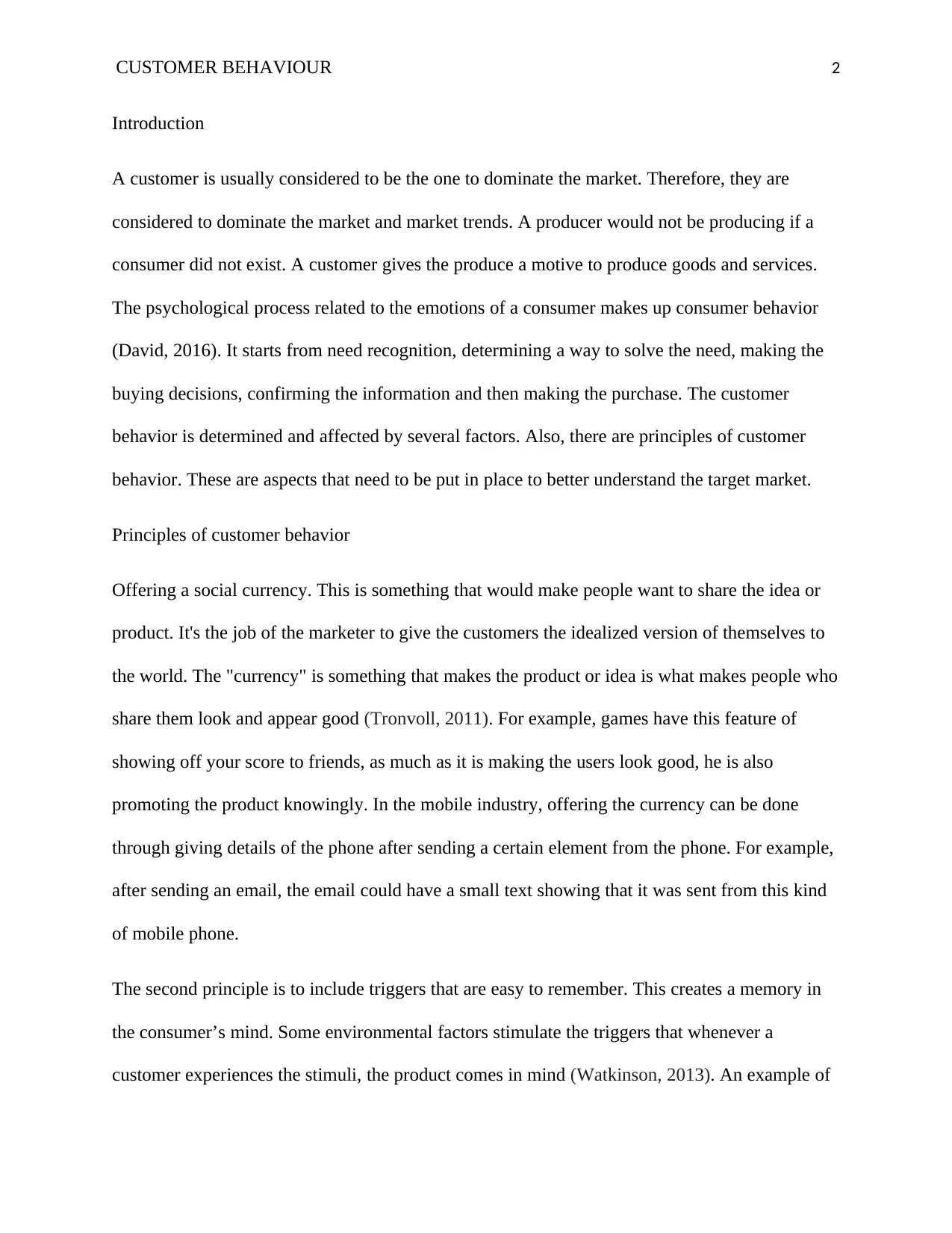
CUSTOMER BEHAVIOUR 2
Introduction
A customer is usually considered to be the one to dominate the market. Therefore, they are
considered to dominate the market and market trends. A producer would not be producing if a
consumer did not exist. A customer gives the produce a motive to produce goods and services.
The psychological process related to the emotions of a consumer makes up consumer behavior
(David, 2016). It starts from need recognition, determining a way to solve the need, making the
buying decisions, confirming the information and then making the purchase. The customer
behavior is determined and affected by several factors. Also, there are principles of customer
behavior. These are aspects that need to be put in place to better understand the target market.
Principles of customer behavior
Offering a social currency. This is something that would make people want to share the idea or
product. It's the job of the marketer to give the customers the idealized version of themselves to
the world. The "currency" is something that makes the product or idea is what makes people who
share them look and appear good (Tronvoll, 2011). For example, games have this feature of
showing off your score to friends, as much as it is making the users look good, he is also
promoting the product knowingly. In the mobile industry, offering the currency can be done
through giving details of the phone after sending a certain element from the phone. For example,
after sending an email, the email could have a small text showing that it was sent from this kind
of mobile phone.
The second principle is to include triggers that are easy to remember. This creates a memory in
the consumer’s mind. Some environmental factors stimulate the triggers that whenever a
customer experiences the stimuli, the product comes in mind (Watkinson, 2013). An example of
Introduction
A customer is usually considered to be the one to dominate the market. Therefore, they are
considered to dominate the market and market trends. A producer would not be producing if a
consumer did not exist. A customer gives the produce a motive to produce goods and services.
The psychological process related to the emotions of a consumer makes up consumer behavior
(David, 2016). It starts from need recognition, determining a way to solve the need, making the
buying decisions, confirming the information and then making the purchase. The customer
behavior is determined and affected by several factors. Also, there are principles of customer
behavior. These are aspects that need to be put in place to better understand the target market.
Principles of customer behavior
Offering a social currency. This is something that would make people want to share the idea or
product. It's the job of the marketer to give the customers the idealized version of themselves to
the world. The "currency" is something that makes the product or idea is what makes people who
share them look and appear good (Tronvoll, 2011). For example, games have this feature of
showing off your score to friends, as much as it is making the users look good, he is also
promoting the product knowingly. In the mobile industry, offering the currency can be done
through giving details of the phone after sending a certain element from the phone. For example,
after sending an email, the email could have a small text showing that it was sent from this kind
of mobile phone.
The second principle is to include triggers that are easy to remember. This creates a memory in
the consumer’s mind. Some environmental factors stimulate the triggers that whenever a
customer experiences the stimuli, the product comes in mind (Watkinson, 2013). An example of
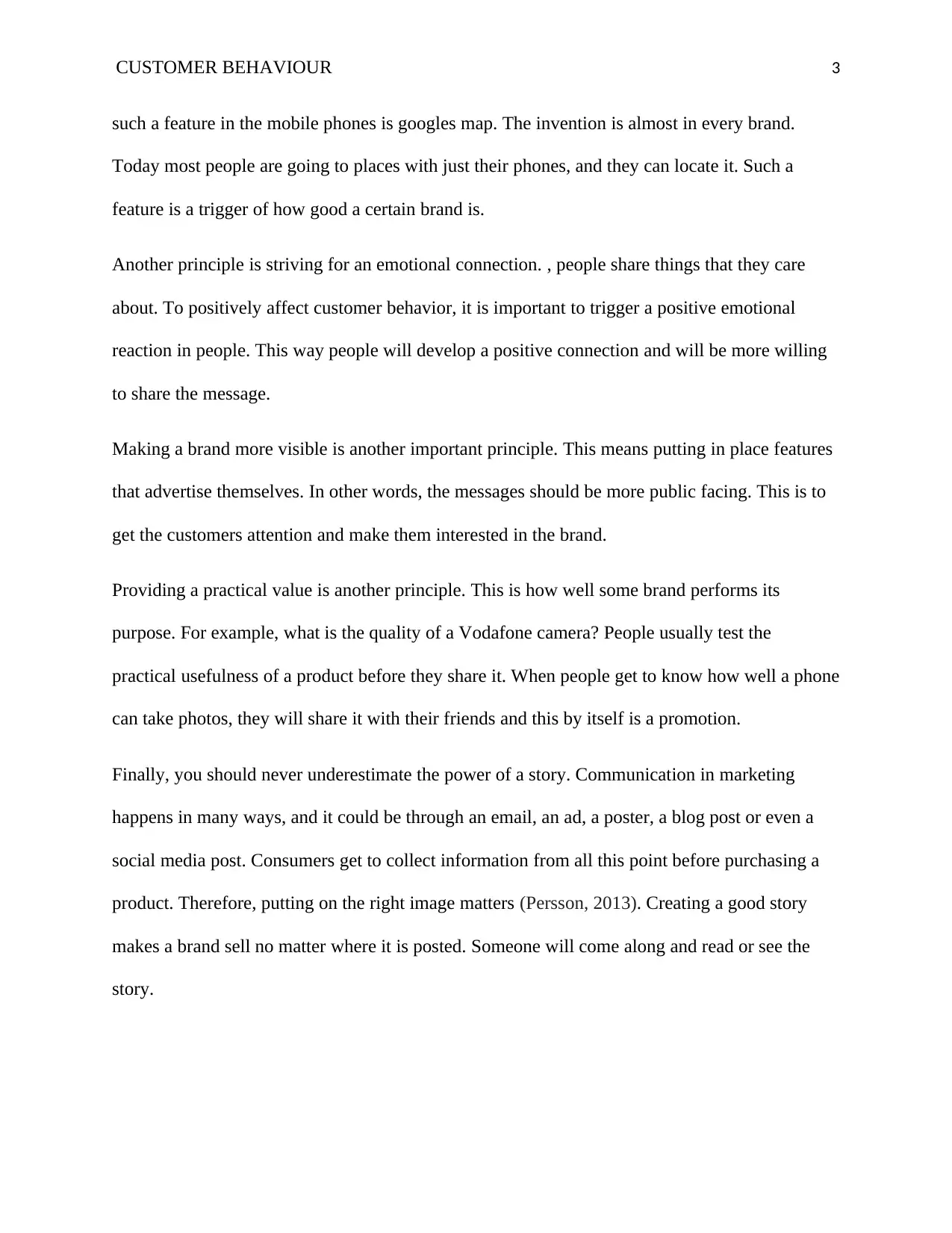
CUSTOMER BEHAVIOUR 3
such a feature in the mobile phones is googles map. The invention is almost in every brand.
Today most people are going to places with just their phones, and they can locate it. Such a
feature is a trigger of how good a certain brand is.
Another principle is striving for an emotional connection. , people share things that they care
about. To positively affect customer behavior, it is important to trigger a positive emotional
reaction in people. This way people will develop a positive connection and will be more willing
to share the message.
Making a brand more visible is another important principle. This means putting in place features
that advertise themselves. In other words, the messages should be more public facing. This is to
get the customers attention and make them interested in the brand.
Providing a practical value is another principle. This is how well some brand performs its
purpose. For example, what is the quality of a Vodafone camera? People usually test the
practical usefulness of a product before they share it. When people get to know how well a phone
can take photos, they will share it with their friends and this by itself is a promotion.
Finally, you should never underestimate the power of a story. Communication in marketing
happens in many ways, and it could be through an email, an ad, a poster, a blog post or even a
social media post. Consumers get to collect information from all this point before purchasing a
product. Therefore, putting on the right image matters (Persson, 2013). Creating a good story
makes a brand sell no matter where it is posted. Someone will come along and read or see the
story.
such a feature in the mobile phones is googles map. The invention is almost in every brand.
Today most people are going to places with just their phones, and they can locate it. Such a
feature is a trigger of how good a certain brand is.
Another principle is striving for an emotional connection. , people share things that they care
about. To positively affect customer behavior, it is important to trigger a positive emotional
reaction in people. This way people will develop a positive connection and will be more willing
to share the message.
Making a brand more visible is another important principle. This means putting in place features
that advertise themselves. In other words, the messages should be more public facing. This is to
get the customers attention and make them interested in the brand.
Providing a practical value is another principle. This is how well some brand performs its
purpose. For example, what is the quality of a Vodafone camera? People usually test the
practical usefulness of a product before they share it. When people get to know how well a phone
can take photos, they will share it with their friends and this by itself is a promotion.
Finally, you should never underestimate the power of a story. Communication in marketing
happens in many ways, and it could be through an email, an ad, a poster, a blog post or even a
social media post. Consumers get to collect information from all this point before purchasing a
product. Therefore, putting on the right image matters (Persson, 2013). Creating a good story
makes a brand sell no matter where it is posted. Someone will come along and read or see the
story.
⊘ This is a preview!⊘
Do you want full access?
Subscribe today to unlock all pages.

Trusted by 1+ million students worldwide
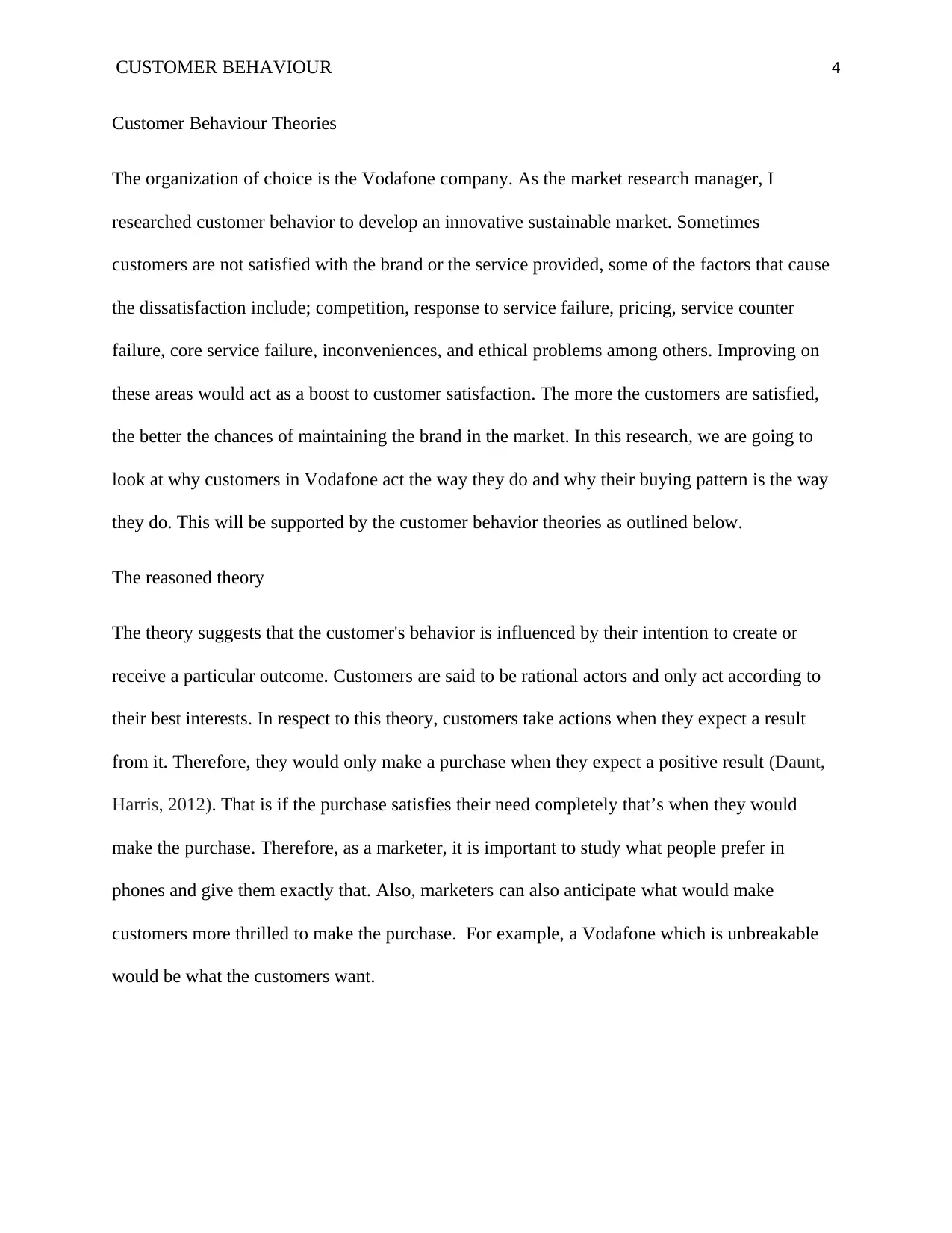
CUSTOMER BEHAVIOUR 4
Customer Behaviour Theories
The organization of choice is the Vodafone company. As the market research manager, I
researched customer behavior to develop an innovative sustainable market. Sometimes
customers are not satisfied with the brand or the service provided, some of the factors that cause
the dissatisfaction include; competition, response to service failure, pricing, service counter
failure, core service failure, inconveniences, and ethical problems among others. Improving on
these areas would act as a boost to customer satisfaction. The more the customers are satisfied,
the better the chances of maintaining the brand in the market. In this research, we are going to
look at why customers in Vodafone act the way they do and why their buying pattern is the way
they do. This will be supported by the customer behavior theories as outlined below.
The reasoned theory
The theory suggests that the customer's behavior is influenced by their intention to create or
receive a particular outcome. Customers are said to be rational actors and only act according to
their best interests. In respect to this theory, customers take actions when they expect a result
from it. Therefore, they would only make a purchase when they expect a positive result (Daunt,
Harris, 2012). That is if the purchase satisfies their need completely that’s when they would
make the purchase. Therefore, as a marketer, it is important to study what people prefer in
phones and give them exactly that. Also, marketers can also anticipate what would make
customers more thrilled to make the purchase. For example, a Vodafone which is unbreakable
would be what the customers want.
Customer Behaviour Theories
The organization of choice is the Vodafone company. As the market research manager, I
researched customer behavior to develop an innovative sustainable market. Sometimes
customers are not satisfied with the brand or the service provided, some of the factors that cause
the dissatisfaction include; competition, response to service failure, pricing, service counter
failure, core service failure, inconveniences, and ethical problems among others. Improving on
these areas would act as a boost to customer satisfaction. The more the customers are satisfied,
the better the chances of maintaining the brand in the market. In this research, we are going to
look at why customers in Vodafone act the way they do and why their buying pattern is the way
they do. This will be supported by the customer behavior theories as outlined below.
The reasoned theory
The theory suggests that the customer's behavior is influenced by their intention to create or
receive a particular outcome. Customers are said to be rational actors and only act according to
their best interests. In respect to this theory, customers take actions when they expect a result
from it. Therefore, they would only make a purchase when they expect a positive result (Daunt,
Harris, 2012). That is if the purchase satisfies their need completely that’s when they would
make the purchase. Therefore, as a marketer, it is important to study what people prefer in
phones and give them exactly that. Also, marketers can also anticipate what would make
customers more thrilled to make the purchase. For example, a Vodafone which is unbreakable
would be what the customers want.
Paraphrase This Document
Need a fresh take? Get an instant paraphrase of this document with our AI Paraphraser
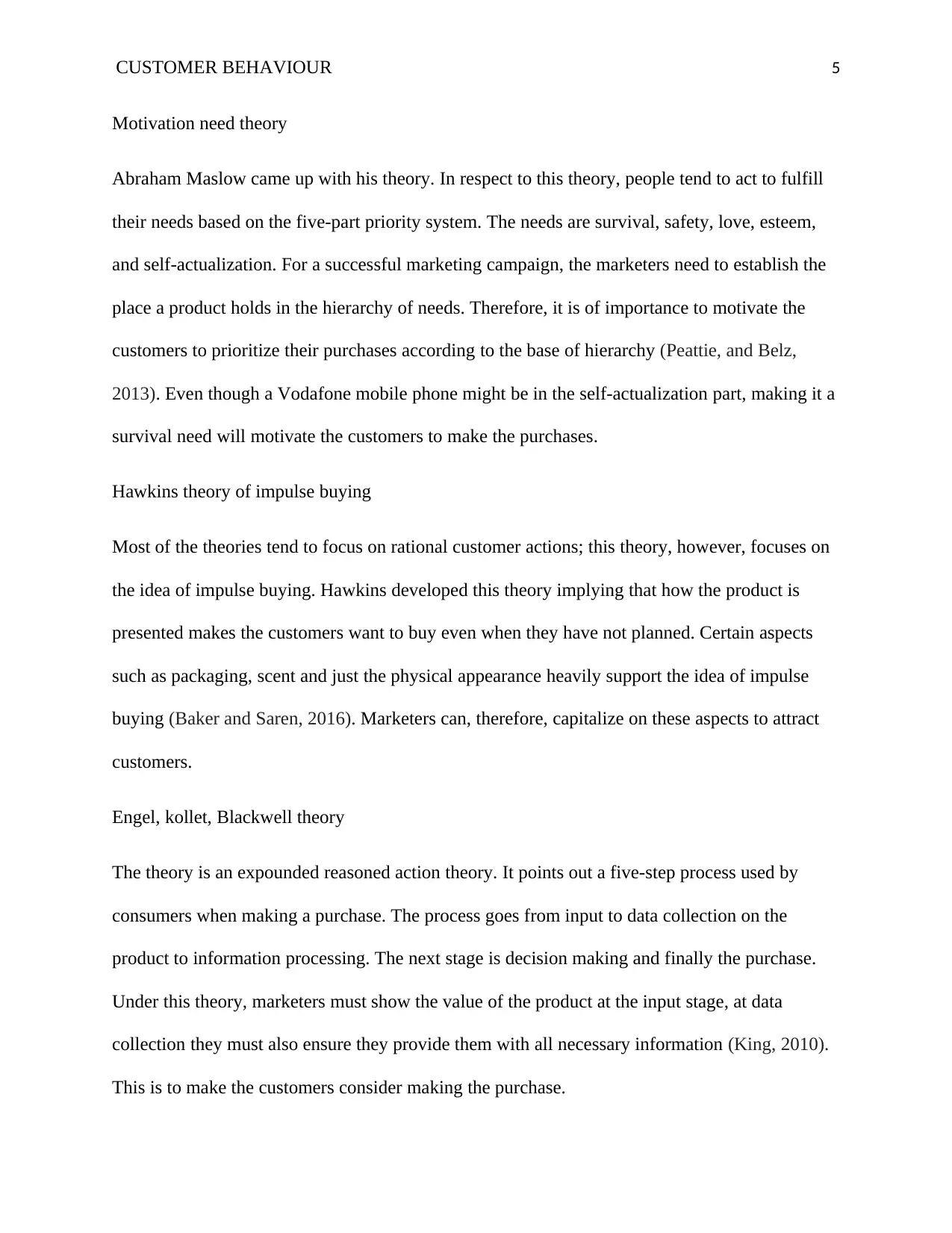
CUSTOMER BEHAVIOUR 5
Motivation need theory
Abraham Maslow came up with his theory. In respect to this theory, people tend to act to fulfill
their needs based on the five-part priority system. The needs are survival, safety, love, esteem,
and self-actualization. For a successful marketing campaign, the marketers need to establish the
place a product holds in the hierarchy of needs. Therefore, it is of importance to motivate the
customers to prioritize their purchases according to the base of hierarchy (Peattie, and Belz,
2013). Even though a Vodafone mobile phone might be in the self-actualization part, making it a
survival need will motivate the customers to make the purchases.
Hawkins theory of impulse buying
Most of the theories tend to focus on rational customer actions; this theory, however, focuses on
the idea of impulse buying. Hawkins developed this theory implying that how the product is
presented makes the customers want to buy even when they have not planned. Certain aspects
such as packaging, scent and just the physical appearance heavily support the idea of impulse
buying (Baker and Saren, 2016). Marketers can, therefore, capitalize on these aspects to attract
customers.
Engel, kollet, Blackwell theory
The theory is an expounded reasoned action theory. It points out a five-step process used by
consumers when making a purchase. The process goes from input to data collection on the
product to information processing. The next stage is decision making and finally the purchase.
Under this theory, marketers must show the value of the product at the input stage, at data
collection they must also ensure they provide them with all necessary information (King, 2010).
This is to make the customers consider making the purchase.
Motivation need theory
Abraham Maslow came up with his theory. In respect to this theory, people tend to act to fulfill
their needs based on the five-part priority system. The needs are survival, safety, love, esteem,
and self-actualization. For a successful marketing campaign, the marketers need to establish the
place a product holds in the hierarchy of needs. Therefore, it is of importance to motivate the
customers to prioritize their purchases according to the base of hierarchy (Peattie, and Belz,
2013). Even though a Vodafone mobile phone might be in the self-actualization part, making it a
survival need will motivate the customers to make the purchases.
Hawkins theory of impulse buying
Most of the theories tend to focus on rational customer actions; this theory, however, focuses on
the idea of impulse buying. Hawkins developed this theory implying that how the product is
presented makes the customers want to buy even when they have not planned. Certain aspects
such as packaging, scent and just the physical appearance heavily support the idea of impulse
buying (Baker and Saren, 2016). Marketers can, therefore, capitalize on these aspects to attract
customers.
Engel, kollet, Blackwell theory
The theory is an expounded reasoned action theory. It points out a five-step process used by
consumers when making a purchase. The process goes from input to data collection on the
product to information processing. The next stage is decision making and finally the purchase.
Under this theory, marketers must show the value of the product at the input stage, at data
collection they must also ensure they provide them with all necessary information (King, 2010).
This is to make the customers consider making the purchase.
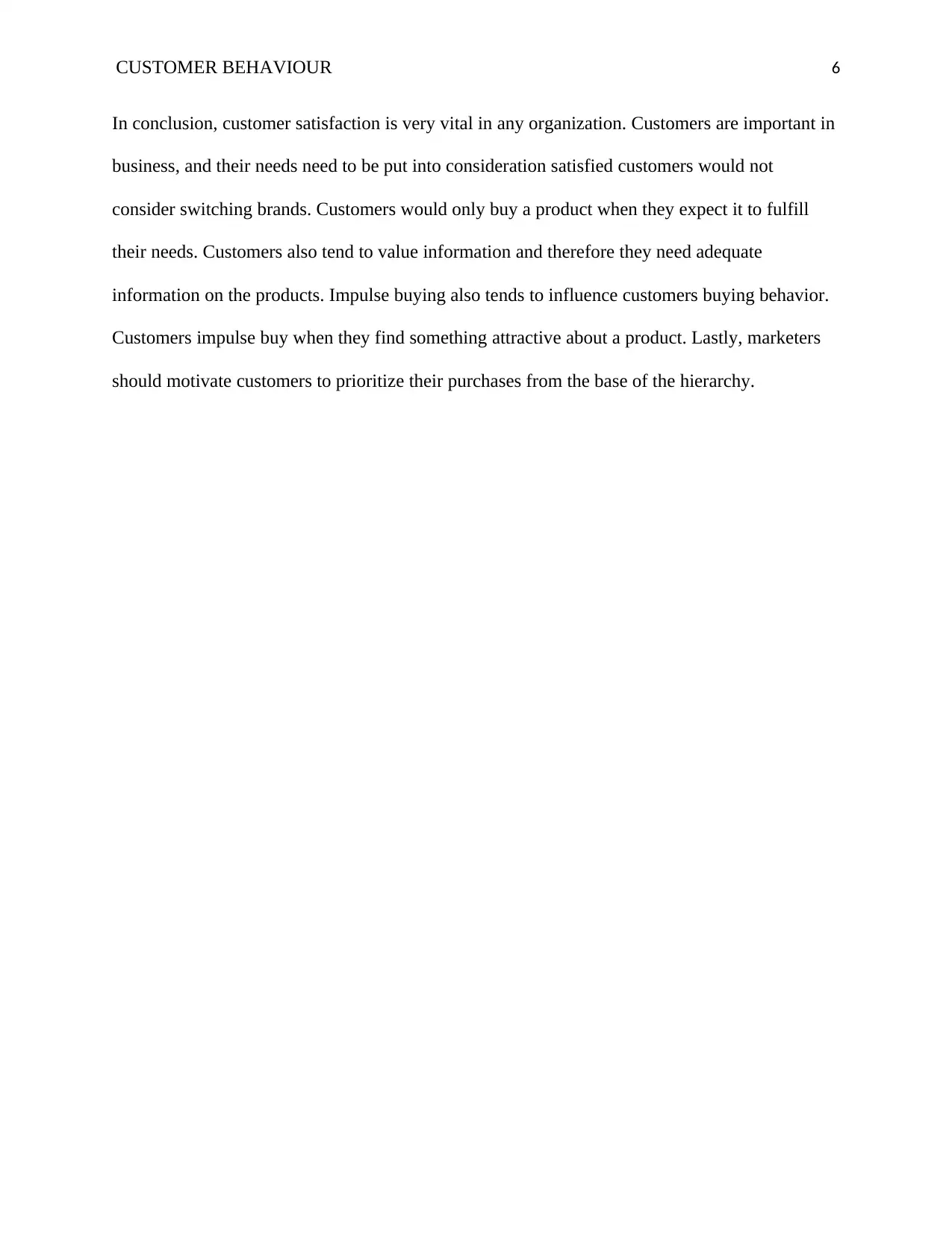
CUSTOMER BEHAVIOUR 6
In conclusion, customer satisfaction is very vital in any organization. Customers are important in
business, and their needs need to be put into consideration satisfied customers would not
consider switching brands. Customers would only buy a product when they expect it to fulfill
their needs. Customers also tend to value information and therefore they need adequate
information on the products. Impulse buying also tends to influence customers buying behavior.
Customers impulse buy when they find something attractive about a product. Lastly, marketers
should motivate customers to prioritize their purchases from the base of the hierarchy.
In conclusion, customer satisfaction is very vital in any organization. Customers are important in
business, and their needs need to be put into consideration satisfied customers would not
consider switching brands. Customers would only buy a product when they expect it to fulfill
their needs. Customers also tend to value information and therefore they need adequate
information on the products. Impulse buying also tends to influence customers buying behavior.
Customers impulse buy when they find something attractive about a product. Lastly, marketers
should motivate customers to prioritize their purchases from the base of the hierarchy.
⊘ This is a preview!⊘
Do you want full access?
Subscribe today to unlock all pages.

Trusted by 1+ million students worldwide
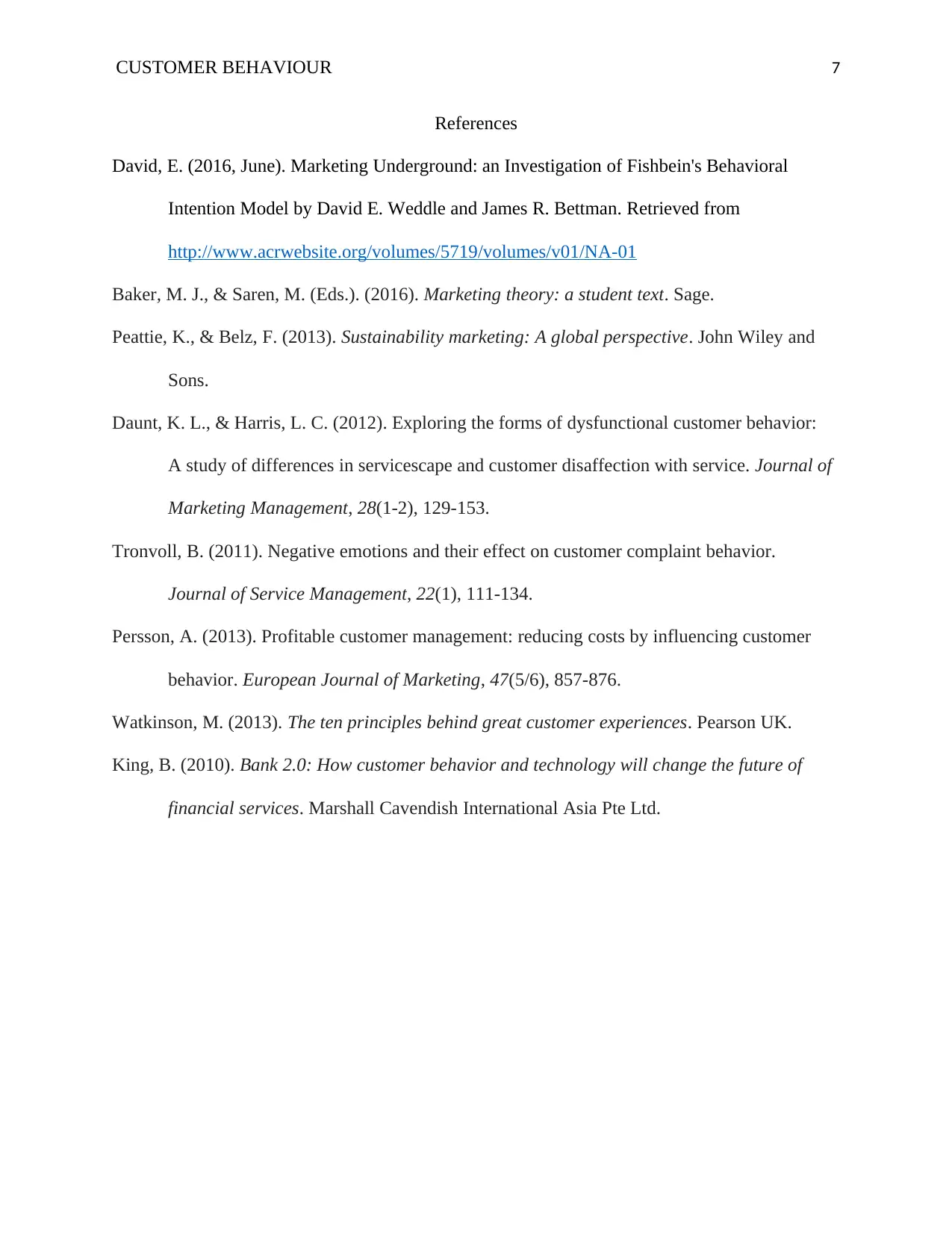
CUSTOMER BEHAVIOUR 7
References
David, E. (2016, June). Marketing Underground: an Investigation of Fishbein's Behavioral
Intention Model by David E. Weddle and James R. Bettman. Retrieved from
http://www.acrwebsite.org/volumes/5719/volumes/v01/NA-01
Baker, M. J., & Saren, M. (Eds.). (2016). Marketing theory: a student text. Sage.
Peattie, K., & Belz, F. (2013). Sustainability marketing: A global perspective. John Wiley and
Sons.
Daunt, K. L., & Harris, L. C. (2012). Exploring the forms of dysfunctional customer behavior:
A study of differences in servicescape and customer disaffection with service. Journal of
Marketing Management, 28(1-2), 129-153.
Tronvoll, B. (2011). Negative emotions and their effect on customer complaint behavior.
Journal of Service Management, 22(1), 111-134.
Persson, A. (2013). Profitable customer management: reducing costs by influencing customer
behavior. European Journal of Marketing, 47(5/6), 857-876.
Watkinson, M. (2013). The ten principles behind great customer experiences. Pearson UK.
King, B. (2010). Bank 2.0: How customer behavior and technology will change the future of
financial services. Marshall Cavendish International Asia Pte Ltd.
References
David, E. (2016, June). Marketing Underground: an Investigation of Fishbein's Behavioral
Intention Model by David E. Weddle and James R. Bettman. Retrieved from
http://www.acrwebsite.org/volumes/5719/volumes/v01/NA-01
Baker, M. J., & Saren, M. (Eds.). (2016). Marketing theory: a student text. Sage.
Peattie, K., & Belz, F. (2013). Sustainability marketing: A global perspective. John Wiley and
Sons.
Daunt, K. L., & Harris, L. C. (2012). Exploring the forms of dysfunctional customer behavior:
A study of differences in servicescape and customer disaffection with service. Journal of
Marketing Management, 28(1-2), 129-153.
Tronvoll, B. (2011). Negative emotions and their effect on customer complaint behavior.
Journal of Service Management, 22(1), 111-134.
Persson, A. (2013). Profitable customer management: reducing costs by influencing customer
behavior. European Journal of Marketing, 47(5/6), 857-876.
Watkinson, M. (2013). The ten principles behind great customer experiences. Pearson UK.
King, B. (2010). Bank 2.0: How customer behavior and technology will change the future of
financial services. Marshall Cavendish International Asia Pte Ltd.
1 out of 7
Related Documents
Your All-in-One AI-Powered Toolkit for Academic Success.
+13062052269
info@desklib.com
Available 24*7 on WhatsApp / Email
![[object Object]](/_next/static/media/star-bottom.7253800d.svg)
Unlock your academic potential
Copyright © 2020–2025 A2Z Services. All Rights Reserved. Developed and managed by ZUCOL.





